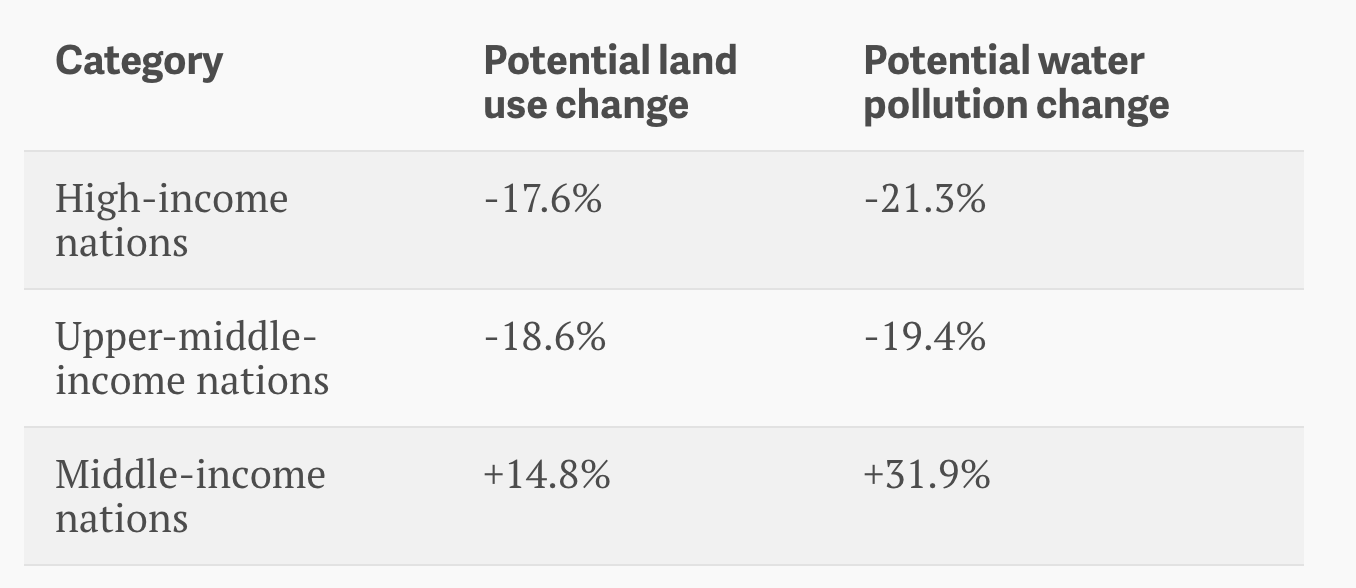The Surprising Benefit Of Actually Following Government Dietary Advice
Researchers analyzed government dietary advice from 37 countries, offering a snapshot of how those policies would impact the global environment if populations in those countries actually took the advice.
If the populations of countries around the world actually took their governments’ dietary advice, they’d be better stewards of the environment.
That’s according to a study (pdf) published this month in the Proceedings of the National Academy of Sciences, in which researchers considered how national dietary recommendations would impact greenhouse gas emissions, land use, and water pollution.
The research offers a snapshot of the patchwork of dietary recommendations governments have recently issued around the world, each particular to its country’s specific dietary needs. In India, for instance, the government has pushed for people to eat more meat, to increase caloric intake and address micronutrient deficiencies. Meanwhile in the US, the government is trying to get people to cut back on meat and eat more plants.
Of the 37 countries considered, only four had included environmental-impact statements with their published recommendations for diets: Sweden, the UK, the Netherlands, and China. As climate change threatens to reshape the food system, policymakers in some places have been eager to contextualize the issue when addressing nutrition. Still, that idea hasn’t been embraced everywhere. Initially, the latest iteration of the US dietary guidelines was planned to include an environmental sustainability portion, but it was quashed by food-industry lobbyists and lawmakers supportive of the industry.
In analyzing the potential environmental effects of dietary recommendations, the scientists used a large and complex food database kept by the UN Food and Agriculture Organization. The overall results showed that if people adopted their nationally-recommended diets in the 37 countries analyzed, the countries’ corresponding environmental footprints would diminish.
It varies by country
However, the study the found impact varied depending on the wealth of the country. In some countries, in fact, adherence to government-recommended diets would actually increase greenhouse-gas emissions.

The study attributes the projected 17% increase in middle-income nations to country-specific dietary recommendations. India and Indonesia, for example, are the only two governments that have called for people to eat more meat to address micronutrient deficiencies, according to the study. Animal agriculture is a contributor to greenhouse gas emissions. In South Africa, the government has been pushing for people to eat more dairy, another source of emissions.
Meanwhile, in the US and in many other high-income countries, the latest dietary guidelines recommend people eat less meat and incorporate more fruits and vegetables into their diets. Those foods are largely associated with fewer greenhouse gas emissions (though at least one controversial study has suggested otherwise).
The researchers found similar trends when looking at what would happen to land use and water pollution if countries actually followed their national dietary recommendations:

It’s tough research
It’s important to keep in mind the research is a large-scale assessment offering outcome models for entire populations. Combing through and assessing that kind of macro-level data has proven difficult, especially when attempting to compare nations equitably.
Brazil and Australia, in the mid-income and high-income brackets, respectively, have emissions that are 200% higher than the average country in their respective brackets—mostly because of meat consumption. In the US, Canada, and Norway (all high-income countries) emissions are about 40% higher than the average for their bracket. Still, all those countries combined have a population less than half of India’s.
There’s no good answer for how to compare the environmental impact of a meat-based dietary recommendation for 1.3 billion people in a low-emission country (like India) to the impact of a plant-based dietary recommendation for 350 million people in a high-emission country (like the US).
Also dietary needs and patterns can become hyper-specific when looking closely at a given country. “Several studies have shown that dietary quality varies not only between nations but also regionally within countries,” the study states, “for example, by socioeconomic background, ethnic background, or rural vs. urban areas.” In particular, the study notes, more data are needed about the diets of disadvantaged groups in order to fully understand how dietary recommendations can impact the environment.
Some scientists have called for more life-cycle analyses, cradle-to-grave assessments that study food products and commodities from inception through the processing, manufacturing, distribution, and disposal stages. That kind of data will help scientists unlock more precise findings on how our food systems and diets impact the world around us.
NEXT STORY: Trump on Shutdown: 'It Could Happen'







